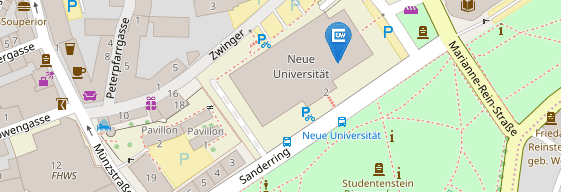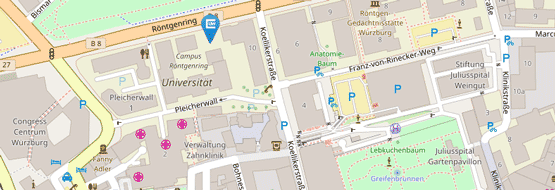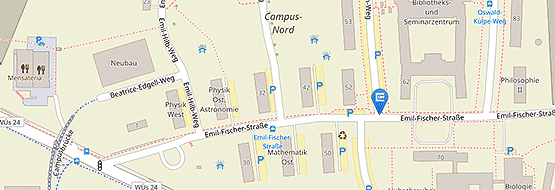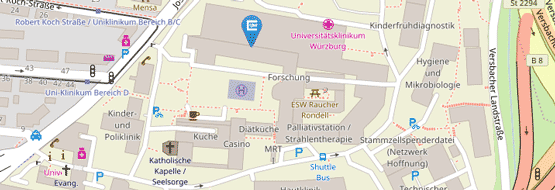Projects
Research areas of Comparative Philology in Würzburg are the phonology, morphology, syntax and lexicology of Indo-European daughter languages including Vedic and Sanskrit, Old Iranian, Greek, Latin, Germanic, Hittite, Armenian and Celtic, and of their common ancestor, Proto-Indo-European; theories of general linguistics including language change and language typology.
An Etymological Dictionary of the Nuristani Nominal Lexicon
Project leader: Dr. des. Jakob Halfmann
The Nuristani languages are a small group of related languages which are spoken in the Afghan province of Nuristan and in adjacent regions of Afghanistan and Pakistan. They are part of the Indo-Iranian branch of the Indo-European language family, but within this branch they occupy a separate historical position and can probably be considered an independent third subgroup next to the Indo-Aryan and Iranian languages. This makes them the only Indo-European branch of such a time depth for which no etymological dictionary is available. The enormous chronological gap between the earliest written attestations of Indo-Aryan and Iranian on the one hand (attested since around the 2nd millenium BCE) and Nuristani on the other (reliably attested only since the 20th century CE) makes it difficult to judge their exact historical relations. An in-depth investigation of the correspondences and differences between Nuristani and the other two branches is therefore necessary in order to better understand the unique historical position of the Nuristani group.
The project “An Etymological Dictionary of the Nuristani Nominal Lexicon”, funded by the German Research Foundation within the Walter Benjamin Program, intends to make a first contribution to this through an etymological investigation of the Nuristani nominal stems. After assigning cognates within Nuristani, connections with the earliest attested stages of the other Indo-Iranian languages will be established, i.e. with Old Indo-Aryan (Vedic & Classical Sanskrit) and Old Iranian (Avestan, Old Persian). Later stages may become relevant as well, e.g. if they offer more direct correspondences or clearer attestations of comparable forms than earlier stages or if borrowing from a later stage is likely. More distant relatives from other Indo-European branches will also be mentioned if the closest cognates can only be found there.
An important goal of the project is to work out the distinctive characteristics (e.g. in terms of sound developments) of the lexical layer inherited from Proto-Indo-Iranian times as opposed to the extensive Middle Indo-Aryan loanword layer, and to clearly separate the two in order to allow a better historical classification of the inherited layer. To achieve this, the comparison to forms of Middle Indo-Aryan (Gāndhārī), attested in the region since the 3rd century BCE, will be of particular importance.
The etymological data will be consistently formatted in TEI markup, which produces a machine-readable version of the data that can not only be turned into a printed dictionary, but also offers the possibility of generating an online dictionary and of making the data available for further processing.
einBLICK
MagEIA: Magic between Entanglement, Interaction and Analogy
Project leaders: Prof. Dr. Daniel Kölligan, Prof. Dr. Daniel Schwemer, Prof. Dr. Martin Stadler
Duration: 01.11.2023–31.10.2027
Texts referred to as 'magical' in modern scholarship are prominent in the written traditions of all ancient cultures of Western Asia and the Eastern Mediterranean, and constitute an important source for the history of religion and ideas in antiquity. Although the problematic nature of the concept of 'magic' is well known, the term itself continues to be used productively in relation to comparable cultural practices characterised by the performance of transformative rituals of various kinds. In overarching studies of the history of magic in Western cultures, magical texts from ancient Egypt and Mesopotamia are now routinely presented alongside the Greco-Roman world as the earliest influences on traditions developing in late antique and post-antique Europe. Handbooks and conference proceedings of this type, however, reflect disciplinary boundaries to a great extent and hardly address cross-cultural correspondences and relationships. Questions about the interconnections, interactions and analogies between the different traditions of magical texts remain unexplored, and the reciprocal relationships remain largely misunderstood.
A collegial research group offers the ideal format to address this desideratum. In this sense, MagEIA is intended to serve as a forum for combining philological and comparative research on ancient magical text traditions and to promote sustained collaboration between different philologies as well as the history of religion, cultural anthropology and archaeology.
MagEIA's research goals unfold in two main phases of four years each. In phase 1, work will focus on three research areas: (1) The interdisciplinary and comparative study of magical text traditions of the Ancient Near East, Egypt and neighbouring regions. (2) The philological and comparative study of emic terminologies for practices and concepts associated with magical text traditions. (3) The development of an annotation method for the comparative analysis and representation of magical texts.
The backbone of MagEIA is formed by the PIs and their teams at the University of Würzburg. The Fellow Programme for researchers specialising in the study of magic in antiquity will ensure that a representative selection of sources is considered. Fellows will enrich the discourse of MagEIA by bringing different research designs, methods, data types and disciplinary perspectives. MagEIA will develop methods of textual analysis and models of cross-cultural comparison that will take the study of magic in antiquity to a new level and inform the study of the dissemination of knowledge and transmission of texts in Western Asia and the Eastern Mediterranean from the third millennium BC to Late Antiquity.
MagEIA-Homepage
CAVAL: The Classical Armenian Valency Lexicon
PI: Dr. Petr Kocharov (Universität Würzburg)
DFG project number: 518003859
Realization period: 2023‒2025
The Classical Armenian Valency Lexicon (CAVAL) project is dedicated to creating a corpus-based valency lexicon and to facilitate access to the verbal morphosyntax of Classical Armenian.
Classical Armenian is the oldest documented variety of the Armenian language, first recorded in the early 5th century. Its grammar represents an intricate fusion of Indo-European archaisms and innovations resulting from internal changes and the contact influence of the neighbouring languages of Eastern Anatolia and the Southern Caucasus. Despite its value for general, typological and historical linguistics, Classical Armenian remains an under-resourced language.
The currently available digital resources include collections of digitized Classical Armenian texts. Only a small share of these texts is provided with morphological annotation, syntactically annotated texts are exceptional. Based on existing resources, CAVAL will result in a corpus of morphologically and syntactically annotated texts, based on which a comprehensive valency lexicon will be generated automatically. The lexicon will be provided with a flexible user interface enabling search queries of argument structures, their morphological expression and lexical distribution with text frequencies.
The proposed project will continue a series of digital valency lexica created for other ancient Indo-European languages, in particular Latin (IT-VaLex, itreebank.marginalia.it) and Homeric Greek (HoDeL, hodel.unipv.it/hodel-res) and will extensively reuse the existing methodological and technological solutions. In order to facilitate research in comparative historical syntax, CAVAL will be provided with an etymological annotation enabling its integration with the valency lexica of other ancient Indo-European languages, the first step towards creating the diachronic valency lexicon of Indo-European languages.
To date, there is no digital valency lexicon for any variety of Armenian; CAVAL will set a model that can be applied to post-classical varieties of Armenian including the two modern literary languages, Eastern and Western Armenian, and modern Armenian dialects.
azg.am
Pilot version of the UD treebank for Classical Armenian
Postclassical Greek Network
PI: Dr. Giuseppina di Bartolo (University of Cologne) & Prof. Dr. Daniel Kölligan (University of Würzburg)
2022/2023
Greek is one of the few languages in the world with an uninterrupted written tradition that spans more than three thousand years. Nearly all periods of Greek are well-documented by large amounts of heterogeneous sources. However, the attention scholarly research has devoted to the different phases of the Greek language is very disproportionate. While the pre-Classical and Classical periods of Greek have been studied for centuries, Postclassical Greek has been focused on only recently.
This scientific network aims at bringing together scholars from all over the world who have been working on Postclassical Greek from different, but especially linguistic, perspectives. Moreover, it seeks to bridge the distance between philological and linguistic approaches regarding the study of Greek.
We are planning a thematic publication and numerous (online and in person) events over the next two years in order to continue the discussion of the "First Postclassical Greek Conference Cologne", to address further research questions related to the network topic and to set up a scientific community.
Further information here.
VedaWeb 2.0
PIs: Prof. Dr. Daniel Kölligan; Prof. Dr. Uta Reinöhl (Universität Freiburg); Dr. Claes Neuefeind (Universität zu Köln); Prof. Dr. Patrick Sahle (Universität Wuppertal)
DFG, Januar 2022 – Dezember 2024
As part of the DFG-funded project VedaWeb 1.0, a web-based open-access platform for the Rigveda with morphological annotation and links to the Sanskrit dictionaries available on Cologne Digital Sanskrit Dictionaries (https://www.sanskrit-lexicon.uni-koeln.de) was developed.
In the second phase, the VedaWeb (https://vedaweb.uni-koeln.de) will be supplemented with functions such as user accounts, which will enable collaborative work on the platform. In this way, all those researching ancient Indo-Aryan texts will be able to contribute to the development of the VedaWeb according to their needs. In addition, the VedaWeb will be expanded to include other texts such as the Atharvaveda and other lexicons from the Cologne Digital Sanskrit Dictionaries. Audio files of recitations of the Rigveda and other ancient Indo-Aryan texts will be made available by the National Library of Denmark (https://www.kb.dk/en). As CLARIN resources, they will become part of the Language Archive Cologne (https://lac.uni-koeln.de/). Another new feature planned is a similarity search, which will allow research on phraseology, motifs, and citations.
All data will be processed according to the FAIR principles (Findability, Accessibility, Interoperability, and Reusability), so that sustainable access is guaranteed.
Ancient Greek accentuation
Alexander von Humboldt Foundation, October 2021 – August 2022 und February 2023 – August 2023
The project concerns ancient Greek accentuation and consists of writing a detailed and comprehensive synthesis book on the topic both from a descriptive and a diachronic point of view. In recent decades, the accentuation of Indo-European languages has undergone a profound renewal: particularly noteworthy, for example, is Alwin Kloekhorst’s book (2014) on accent in Hittite, as well as the many publications that have come out of the numerous conferences held in the field of Baltic and Slavic accentuation. While focusing on ancient Greek, the project is not aimed at an audience composed exclusively of researchers in the field of ancient Greek, but at the community of philologists and linguists specialising in the field of Indo-European studies, and even, beyond Indo-Europeanists, at all those who are interested in the genesis of linguistic systems. The project aims to replace Joseph Vendryes’ Traité d’accentuation grecque (1904), the only comprehensive treatment of Greek accentuation so far from both a synchronic and a diachronic point of view, and to fill some of its lacunae, e.g. on accentuation in Greek dialects, nominal formations, and clitics.
A new edition of the second oldest Indian text, the Śaunakasaṃhitā of the Atharvaveda together with a word index of the Paippalādasaṃhitā and Śaunakasaṃhitā
DFG, 01.01.2022 – 31.05.2023
The Index Verborum of the Paippalāda and Śaunakasaṃhitā of the Atharvaveda, already begun five years ago, is to be completed as a continuation project (A new edition of the second oldest Indian text, the Śaunakasaṃhitā of the Atharvaveda together with the preparation of an Index verborum of the Paippalādasaṃhitā and Śaunakasaṃhitā). The lemmas from the Śaunakasaṃhitā were compiled during the applicant's completed project (Atharvavedasaṃhitā of the Śaunakaśākhā. A new edition with special reference to the parallel passages of the Paippalādasaṃhitā. Status: December 2021) has been included in its entirety. The index section of the Paippalādasaṃhitā will be completed in the continuation project. The index of the Paippalādasaṃhitā will be a first and will serve as a basis for further research. At the end of the project, both an index verborum of the Śaunakasaṃhitā and one of the Paippalādasaṃhitā will be available.
[Soon Harvard Oriental Series (HOS) No. 101]
The Lexicon-Grammar Interface in the History of the Old Armenian Verb (March 2021 – November 2022)
Alexander von Humboldt Foundation, March 2021 – November 2022
The evolution of the verbal system from Proto-Indo-European (PIE) to Classical Armenian, spanning over three millennia, presents many puzzles for historical comparative Indo-European linguistics. Only a relatively small number of Armenian verbs can be securely derived from PIE verbs. These verbs show an intricate combination of archaisms and innovations in their morphological structure. After over a hundred years of research, the exact scope of archaisms and innovations is still debated and the conditioning factors of morphological features remain unexplained.
Attempts to explain how the PIE verbal system evolved into that of Classical Armenian require establishing, among other things, diachronic connections between multiple PIE and Armenian verbal classes. The aim of the proposed research is to trace the continuity of verbal classes from PIE to Armenian and to describe the morphological changes as conditioned by sound laws and different kinds of analogy. The proposed research will aim to elucidate the source and motivation for the analogical changes based on: a) formal features of verbal classes; b) argument structure; c) actionality and aspectual features; d) lexical semantics. In compliance with the research objectives a detailed examination of the argumental and aspectual properties of the inherited Armenian verbs and their PIE antecedents will be carried out. The obtained results will become an essential contribution to the comparative grammar of Armenian and provide new data on the long-term evolution of verbal systems to the adjacent sub-fields of general and typological linguistics.
A new edition of the second oldest Indic text, the Śaunakasaṃhitā of the Atharvaveda, including a word index of the Paippalādasaṃhitā and the Śaunakasaṃhitā
DFG, 2018–2021
After the completion of the project "The Paippalādasaṃhitā of the Atharvaveda. Kāṇḍa 8 and 9. A new edition with translation and commentary" (Dettelbach 2014) the creation of an index verborum by Dr. Jeong-Soo Kim was started in early 2015. The first step was to create an improved version of Kāṇḍa 16 of the Paippalādasaṃhitā, a large book containing 155 Kāṇḍikās. After this, both published not yet published Kāṇḍa editions were checked and included in the word index.
The new edition of the Śaunakīyasaṃhitā, which started at the beginning of 2017, was funded by the DFG initially for 3 years (starting May 2018) (summary). The tokens of the new AVŚ-text will successively find their way into the index verborum and the lemmas already included in the index verborum will be helpful for a better reading of the AVŚ-text to be created. Thus the new text of the Śaunakīyasaṃhitā is in a complementary relationship with the index verborum.
Publication on the server of the UB Würzburg: Atharvavedasaṃhitā der Śaunakaśākhā. Eine neue Edition unter besonderer Berücksichtigung der Parallelstellen der Paippalādasaṃhitā
For Atharvavedasaṃhitā der Śaunakaśākhā. Eine neue Edition (TEI) see Links to VedaWeb related resources.
VedaWeb (July 2017 – June 2020)
PIs: Prof. Dr. Daniel Kölligan; Prof. Dr. Uta Reinöhl (Universität Freiburg); Dr. Claes Neuefeind (Universität zu Köln); Prof. Dr. Patrick Sahle (Universität Wuppertal)
DFG, July 2017 – June 2020
This DFG-funded project provides a webbased open-access platform for linguistic research on Old Indic texts. The corpus is morphologically annotated and may be searched combining lexicographic and linguistic criteria. VedaWeb is part of the platform Cologne South Asian Languages and Texts (C-SALT).
The pilot text used for establishing the platform is the Rigveda, linked via C-SALT APIs to the Sanskrit dictionaries available at the Cologne Digital Sanskrit Dictionaries site. The morphological annotations of the Rigveda have been provided by our project partners at the University of Zurich (UZH), Prof. Dr. Paul Widmer and colleagues.
A new edition of Kanda 8 and 9 of the Paippaladasamhita of the Atharvaveda with translation and commentary
DFG, 2011–2014
The Atharvaveda Paippalada-Samhita is one of the oldest texts of India, a text of utmost importance both for cultural history and linguistics. This second-oldest text after the Rigveda originally existed in 9 versions, so-called "sakhas". However, only two recensions, the so-called Paippalada- and the Saunaka-Samhita, have survived. While for the Atharvaveda text of the Saunakiya recension there exists a reliable edition by Roth & Whitney (1856), excellently complemented by Vishva Bandhu 1960-1962, the study of the Paippalada recension originating from Orissa has received a major boost through new manuscripts found in recent times. Inspired by the works of Zehnder (1999), Lubotsky (2002) and Griffiths (2009), an international group of researchers is now working on various books of the Paippalada recension from Orissa. The aim of the project proposed here is to contribute to this research with an annotated edition of books ("Kandas") 8 and 9 of the Paippalada Samhita.
Investigation of love magic texts from Greek and Roman antiquity
April 2017 – October 2018
In this research project, Greek and Latin love magic texts will be examined with regard to their vocabulary, their morphological and syntactic peculiarities and, above all, their formulas and textual structure. The aim is to identify the lexical, phraseological, syntactic and textual features that are characteristic for this genre of magic texts. The results obtained in this way can then serve as a starting point for a cross-linguistic analysis of similar magic texts in other language traditions, since in antiquity magic texts for love purposes were written in many regions including the Ancient Near East and Egypt and are also well attested in the Atharvaveda. This allows a comparative study of magic texts.
The files linked below give an overview of the instructional texts and primary testimonies (curse tablets), which form the Greek corpus, and the compilation of the names of love-motivated magic rituals and their components.
Bodily harm in Old Irish Law
PI: Dr. Bernd Vath
August 2016 – July 2019
The project deals with the old Irish legal text Di ércib fola "About éric punishments in cases of bloodshed", including the corresponding Middle Irish commentaries.
The legal text itself is available in two editions with rather free English translations. Te project plans to edit the text and provide it with a German translation and an attached glossary. This work will also be the PI's PhD thesis. The glossary will be as compatible as possible with the standard lexicon for Old and Middle Irish, the "Dictionary of the Irish Language" (DIL), in order to allow a possible adoption of this material into the DIL, which so far covers little of the legal vocabulary of old and middle Irish texts. The planned edition with a glossary of the legal vocabulary from Di ércib fola will be a step to close this considerable gap in the DIL. It can be seen as a piloting work for the lexicographic processing of the difficult legal terminology in Irish: The Corpus Iuris Hibernici (CIH), the currently authoritative text edition of older Irish law, comprises a total of 6 volumes with more than 2300 pages. The majority of the material of this corpus has not yet been recorded in the DIL.
See Completed theses
Infinitives and their precursors in Vedic and Greek
PIs: Prof. Dr. Karin Stüber; Prof. Dr. Heinrich Hettrich †
The projects studies the use of verbal abstracts in Vedic, especially in final function, and of the infinitive in Homeric Greek. The aim is to show syntactic structures that are common to both languages and can therefore be considered inherited. Means of expression in Vedic are essentially case forms of verbal abstracts formed with different suffixes, while Greek uses infinitives in the same contexts, also used as a complement infinitive.
Heinrich Hettrich is responsible for the Vedic part of the study, Karin Stüber for the Greek part.
The function and development of local particles in Vedic
PI: Prof. Dr. Heinrich Hettrich †
DFG, 2008–2016
In Indo-European studies, it is common widsom that the preverbs and adpositions of the daughter languages have developed from independent adverbs of Proto-Indo-European (called local particles - LP -). For the verbs, this can be recognized in the earliest phases of the individual languages (Hittite, Vedic, Old Avestan, Homeric Greek) by the fact that in many cases a - semantic as well as formal - univerbation of LP and verb has not yet taken place, so that in many cases it is not yet possible to speak of preverbs proper. Furthermore, many of these subsequent adpositions can still be used as independent adverbs in these early languages stages, without a fixed assignment to a noun or verb.
So far, there is no comprehensive study that examines the implications of these hypotheses for the Indo-European protolanguage as well as the possible developments in the oldest daughter languages. The project plans to undertake this for the language of Rgveda. As first result, one may note that LPs are indeed still to be understood as independent adverbs, which - as far as they have a reference noun - do not govern it, but only modify it as an attribute or apposition and - as far as they syntactically belong to a verb - are often neither semantically nor formally fused with it. However, this rule seems to be valid for the different Vedic LPs to a very different extent, and it seems that the language of the Rgveda shows a gradient scale from adverbial LP to full appositions. The project aims at a fundamental and detailed description of the language of the RV in this respect, which will then be an essential prerequisite for a reliable reconstruction of the original language state.










